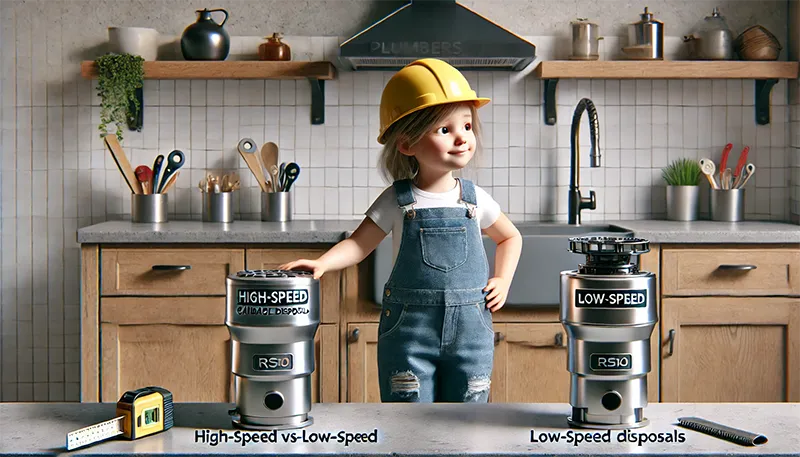When choosing a garbage disposal, one of the most important factors to consider is motor speed. The speed at which a garbage disposal operates, measured in revolutions per minute (RPM), directly impacts its efficiency, performance, and ability to handle different types of food waste.
In this guide, we’ll explore the differences between high-speed vs low-speed garbage disposals, including their pros, cons, and best use cases. By the end, you’ll know which type of disposal is the best fit for your kitchen needs.
What Is a High-Speed Garbage Disposal?
A high-speed garbage disposal operates at speeds of 2,500 RPM or higher. These disposals are designed for fast and efficient grinding, making them suitable for handling tough food waste.
Key Features:
- Motor Speeds: Typically between 2,500 and 3,500 RPM.
- Fast Grinding: Quickly processes food waste, reducing the risk of jams.
- Heavy-Duty Performance: Can handle tough items like small bones and fibrous vegetables.
Pros and Cons of High-Speed Garbage Disposals
Pros:
✅ Fast and Efficient: Quickly grinds food waste, reducing the chance of clogs and jams.
✅ Handles Tough Waste: Effective for grinding bones, fibrous foods, and dense materials.
✅ Reduced Jams: High-speed grinding minimizes the chance of blockages.
✅ Ideal for Large Households: Great for kitchens that produce a lot of food waste.
Cons:
❌ Noisier Operation: Can be louder without sound insulation.
❌ Higher Energy Consumption: Uses more power due to the high-speed motor.
❌ More Expensive: Typically costs more than low-speed models.
What Is a Low-Speed Garbage Disposal?
A low-speed garbage disposal operates at speeds between 1,500 and 2,000 RPM. These disposals offer a slower, steady grind, making them suitable for light to moderate food waste.
Key Features:
- Motor Speeds: Usually between 1,500 and 2,000 RPM.
- Gentle Grinding: Slower grinding reduces noise and vibration.
- Energy-Efficient: Uses less power compared to high-speed models.
Pros and Cons of Low-Speed Garbage Disposals
Pros:
✅ Quieter Operation: Slower grinding typically results in less noise.
✅ Energy-Efficient: Consumes less power, making it eco-friendly.
✅ Affordable: Generally more budget-friendly than high-speed models.
✅ Ideal for Small Households: Perfect for kitchens with light food waste.
Cons:
❌ Higher Chance of Jams: More prone to clogs with tough or fibrous waste.
❌ Slower Grinding: Takes longer to process food waste.
❌ Limited Capability: Not suitable for grinding bones or dense materials.
Key Differences Between High-Speed and Low-Speed Disposals
| Feature | High-Speed Disposals | Low-Speed Disposals |
|---|---|---|
| Motor Speed | 2,500 RPM or higher | 1,500-2,000 RPM |
| Grinding Efficiency | Fast, handles tough waste | Slower, best for soft waste |
| Noise Levels | Louder unless insulated | Quieter operation |
| Energy Consumption | Higher energy use | More energy-efficient |
| Cost | Typically more expensive | More affordable |
| Best For | Large households, tough waste | Small households, light to moderate use |
Which Type of Garbage Disposal Is Right for You?
Choose a High-Speed Disposal If:
- You have a large household or generate a lot of food waste.
- You frequently grind tough items like bones, fibrous vegetables, and dense scraps.
- You prefer faster grinding with fewer chances of jams.
Recommended High-Speed Models:
- Waste King L-8000 (1 HP, 2,800 RPM)
- Powerful motor, jam-resistant, and easy to install.
- InSinkErator Evolution Excel (1 HP, MultiGrind, 2,750 RPM)
- Multi-stage grinding, sound insulation, and superior performance.
Choose a Low-Speed Disposal If:
- You have a small household or generate light food waste.
- You prioritize quiet operation and energy efficiency.
- You’re looking for a budget-friendly option for basic needs.
Recommended Low-Speed Models:
- InSinkErator Badger 5 (1/2 HP, 1,725 RPM)
- Reliable, affordable, and great for moderate use.
- Moen GX50C Prep Series (1/2 HP, 1,900 RPM)
- Compact design, quiet operation, and ideal for small kitchens.
Maintenance Tips for Both Types of Disposals
- Run Cold Water During Use:
- Helps flush waste efficiently and prevent clogs.
- Clean Regularly:
- Use baking soda and vinegar to deodorize and clean the grinding chamber.
- Avoid Hard and Fibrous Foods:
- Prevents jams, especially in low-speed models.
- Grind Ice Cubes:
- Cleans the blades and dislodges debris.
- Check for Leaks Periodically:
- Inspect connections to avoid water damage.
FAQs
What RPM is considered high-speed for garbage disposals?
Disposals with speeds of 2,500 RPM or higher are considered high-speed.
Are high-speed disposals noisier than low-speed ones?
Yes, but many high-speed models come with sound insulation to reduce noise.
Can low-speed disposals handle bones?
No, low-speed disposals are best for light food waste and may jam with hard items like bones.
Do high-speed disposals use more electricity?
Yes, they tend to consume more energy due to their powerful motors.
Which disposal type lasts longer?
Both types can last 8-15 years with proper maintenance, but high-speed disposals are better suited for heavy-duty use.
Conclusion
Choosing between a high-speed and low-speed garbage disposal depends on your household size, the type of food waste you produce, and your budget.
High-speed disposals offer powerful performance for heavy-duty tasks, while low-speed disposals provide quieter, energy-efficient operation for smaller households.
Which type of garbage disposal do you prefer? Share your experiences and tips on social media to help others make the right choice for their kitchen!



